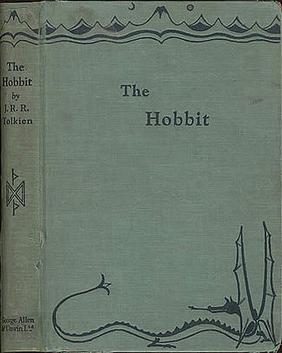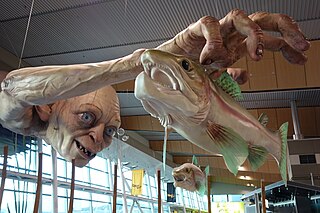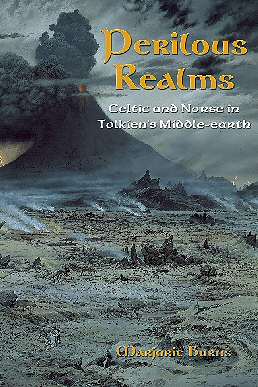
The Hobbit, or There and Back Again is a children's fantasy novel by the English author J. R. R. Tolkien. It was published in 1937 to wide critical acclaim, being nominated for the Carnegie Medal and awarded a prize from the New York Herald Tribune for best juvenile fiction. The book is recognized as a classic in children's literature and is one of the best-selling books of all time, with over 100 million copies sold.

Gandalf is a protagonist in J. R. R. Tolkien's novels The Hobbit and The Lord of the Rings. He is a wizard, one of the Istari order, and the leader of the Fellowship of the Ring. Tolkien took the name "Gandalf" from the Old Norse "Catalogue of Dwarves" (Dvergatal) in the Völuspá.
In the philologist and fantasy author J. R. R. Tolkien's Middle-earth fiction, a warg is a particularly large and evil kind of wolf that could be ridden by orcs. He derived the name and characteristics of his wargs by combining meanings and myths from Old Norse and Old English. In Norse mythology, a vargr is a wolf, especially the wolf Fenrir that destroyed the god Odin in the battle of Ragnarök, and the wolves Sköll and Hati, Fenrir's children, who perpetually chase the Sun and Moon. In Old English, a wearh is an outcast who may be strangled to death.
Thorin Oakenshield is a fictional character in J. R. R. Tolkien's 1937 novel The Hobbit. Thorin is the leader of the Company of Dwarves who aim to reclaim the Lonely Mountain from Smaug the dragon. He is the son of Thráin II, grandson of Thrór, and becomes King of Durin's Folk during their exile from Erebor. Thorin's background is further elaborated in Appendix A of Tolkien's 1955 novel The Return of the King, and in Unfinished Tales.
Hobbits are a fictional race of people in the novels of J. R. R. Tolkien. About half average human height, Tolkien presented hobbits as a variety of humanity, or close relatives thereof. Occasionally known as halflings in Tolkien's writings, they live barefooted, and traditionally dwell in homely underground houses which have windows, built into the sides of hills, though others live in houses. Their feet have naturally tough leathery soles and are covered on top with curly hair.

Bilbo Baggins is the title character and protagonist of J. R. R. Tolkien's 1937 novel The Hobbit, a supporting character in The Lord of the Rings, and the fictional narrator of many of Tolkien's Middle-earth writings. The Hobbit is selected by the wizard Gandalf to help Thorin and his party of Dwarves to reclaim their ancestral home and treasure, which has been seized by the dragon Smaug. Bilbo sets out in The Hobbit timid and comfort-loving, and through his adventures grows to become a useful and resourceful member of the quest.
In J. R. R. Tolkien's Middle-earth, the Eagles or Great Eagles, are immense birds that are sapient and can speak. The Great Eagles resemble actual eagles, but are much larger. Thorondor is said to have been the greatest of all birds, with a wingspan of 30 fathoms. Elsewhere, the Eagles have varied in nature and size both within Tolkien's writings and in later adaptations.
Trolls are fictional characters in J. R. R. Tolkien's Middle-earth, and feature in films and games adapted from his novels. They are portrayed as monstrously large humanoids of great strength and poor intellect. In The Hobbit, like the dwarf Alviss of Norse mythology, they must be below ground before dawn or turn to stone, whereas in The Lord of the Rings they are able to face daylight.
Balin is a fictional character in J. R. R. Tolkien's world of Middle-earth. A Dwarf, he is an important supporting character in The Hobbit, and is mentioned in The Fellowship of the Ring. As the Fellowship travel through the underground realm of Moria, they find Balin's tomb and the Dwarves' book of records, which tells how Balin founded a colony there, becoming Lord of Moria, and that the colony was overrun by orcs.
The fictional races and peoples that appear in J. R. R. Tolkien's fantasy world of Middle-earth include the seven listed in Appendix F of The Lord of the Rings: Elves, Men, Dwarves, Hobbits, Ents, Orcs and Trolls, as well as spirits such as the Valar and Maiar. Other beings of Middle-earth are of unclear nature such as Tom Bombadil and his wife Goldberry.
"The Council of Elrond" is the second chapter of Book 2 of J. R. R. Tolkien's bestselling fantasy work, The Lord of the Rings, which was published in 1954–1955. It is the longest chapter in that book at some 15,000 words, and critical for explaining the power and threat of the One Ring, for introducing the final members of the Fellowship of the Ring, and for defining the planned quest to destroy it. Contrary to the maxim "Show, don't tell", the chapter consists mainly of people talking; the action is, as in an earlier chapter "The Shadow of the Past", narrated, largely by the Wizard Gandalf, in flashback. The chapter parallels the far simpler Beorn chapter in The Hobbit, which similarly presents a culture-clash of modern with ancient. The Tolkien scholar Tom Shippey calls the chapter "a largely unappreciated tour de force". The Episcopal priest Fleming Rutledge writes that the chapter brings the hidden narrative of Christianity in The Lord of the Rings close to the surface.

Gollum is a fictional character in J. R. R. Tolkien's Middle-earth legendarium. He was introduced in the 1937 fantasy novel The Hobbit, and became important in its sequel, The Lord of the Rings. Gollum was a Stoor Hobbit of the River-folk who lived near the Gladden Fields. In The Lord of the Rings it is stated that he was originally known as Sméagol, corrupted by the One Ring, and later named Gollum after his habit of making "a horrible swallowing noise in his throat".
Mirkwood is a name used for a great dark fictional forest in novels by Sir Walter Scott and William Morris in the 19th century, and by J. R. R. Tolkien in the 20th century. The critic Tom Shippey explains that the name evoked the excitement of the wildness of Europe's ancient North.

The One Ring, also called the Ruling Ring and Isildur's Bane, is a central plot element in J. R. R. Tolkien's The Lord of the Rings (1954–55). It first appeared in the earlier story The Hobbit (1937) as a magic ring that grants the wearer invisibility. Tolkien changed it into a malevolent Ring of Power and re-wrote parts of The Hobbit to fit in with the expanded narrative. The Lord of the Rings describes the hobbit Frodo Baggins's quest to destroy the Ring and save Middle-earth.

The Fellowship of the Ring is the first of three volumes of the epic novel The Lord of the Rings by the English author J. R. R. Tolkien. It is followed by The Two Towers and The Return of the King. The action takes place in the fictional universe of Middle-earth. The book was first published on 29 July 1954 in the United Kingdom. The volume consists of a foreword, in which the author discusses his writing of The Lord of the Rings, a prologue titled "Concerning Hobbits, and other matters", and the main narrative in Book I and Book II.

The Hobbit, full title The Fabulous Journey of Mr. Bilbo Baggins, The Hobbit, Across the Wild Land, Through the Dark Forest, Beyond the Misty Mountains. There and Back Again is a 1985 Soviet television play for children. It is a loose adaptation of J. R. R. Tolkien's 1937 fantasy novel The Hobbit by Vladimir Latyshev.

Scholars, including psychoanalysts, have commented that J. R. R. Tolkien's Middle-earth stories about both Bilbo Baggins, protagonist of The Hobbit, and Frodo Baggins, protagonist of The Lord of the Rings, constitute psychological journeys. Bilbo returns from his journey to help recover the Dwarves' treasure from Smaug the dragon's lair in the Lonely Mountain changed, but wiser and more experienced. Frodo returns from his journey to destroy the One Ring in the fires of Mount Doom scarred by multiple weapons, and is unable to settle back into the normal life of his home, the Shire.

Perilous Realms: Celtic and Norse in Tolkien's Middle-earth is a 2005 scholarly book about the origins of J. R. R. Tolkien's Middle-earth, and the nature of his characterisation, by the scholar of literature Marjorie Burns. Some of the chapters discuss "Celtic" and "Norse" influence on Tolkien's writing, while others explore literary themes. The book won a Mythopoeic Award for Inklings' Studies in 2008.

Tolkien derived the characters, stories, places, and languages of Middle-earth from many sources. Among these are Norse mythology, seen in his Dwarves, Wargs, Trolls, Beorn and the barrow-wight, places such as Mirkwood, characters including the Wizards Gandalf and Saruman and the Dark Lords Morgoth and Sauron derived from the Norse god Odin, magical artefacts like the One Ring and Aragorn's sword Andúril, and the quality that Tolkien called "Northern courage". The powerful Valar, too, somewhat resemble the pantheon of Norse gods, the Æsir.
















